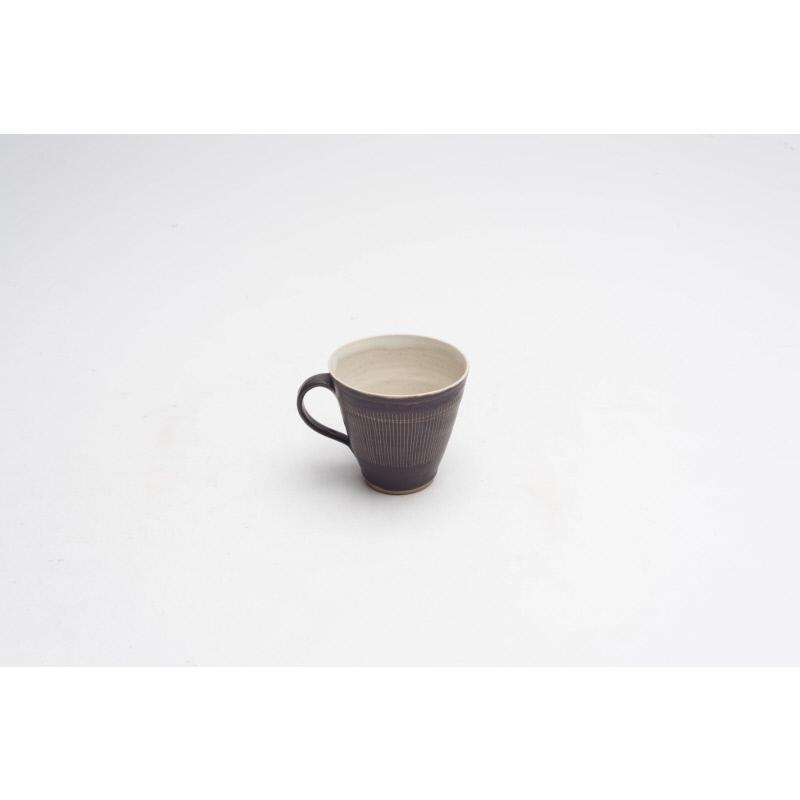Currently indexing
Teacup
Classification(s):
Pottery
Date: c. 1951-1976
Maker: Lucie Rie (Austrian-British, 1902 - 1995)
Dimensions:
75 × 96 mm (7.5 × 9.6 cm)
Medium: Ceramic
Object number: CC047
See Also
(not assigned):England
DescriptionGlazed ceramic teacup by Lucie Rie. The cup has a brown glaze and is decorated with sgraffito vertical lines around the body, intersected by 2 thin horizontal lines. The interior of the cup has a speckled white glaze. The potter’s initials, “LR” is stamped to base.
ProvenanceThis object was originally acquired for the Inner London Education Authority’s (ILEA) ‘Circulating Design Scheme’ collection.
The collection was instigated by the London Country Council (later the Greater London Council) and the Council of Industrial Design (COID). The collection’s original purpose was concerned with the teaching and dissemination of modern, ‘good design’.
The collection was established in 1951/52 as the ‘Experiment in Design Appreciation’, later renamed the ‘Circulating Design Scheme’.
The Circulating Design Scheme lent boxed showcases to London schools. The showcases contained handling objects, material samples and interpretation on a specific subject.
COID withdrew its involvement in the Scheme in 1957. After which time, it was managed exclusively by the London County Council from 1957-1963.
After the administrative restructuring of London authorities, the Scheme was jointly managed by the Greater London Council and the Inner London Education Authority (ILEA) from 1963 – 1976.
The Scheme was operational until 1976 when the collections were withdrawn from circulation. ILEA was abolished in the late 1980s and the collection was donated to Camberwell College of Arts in 1989/90.
ILEA was responsible for secondary and tertiary education in the inner London boroughs, this included Camberwell.
The collection was instigated by the London Country Council (later the Greater London Council) and the Council of Industrial Design (COID). The collection’s original purpose was concerned with the teaching and dissemination of modern, ‘good design’.
The collection was established in 1951/52 as the ‘Experiment in Design Appreciation’, later renamed the ‘Circulating Design Scheme’.
The Circulating Design Scheme lent boxed showcases to London schools. The showcases contained handling objects, material samples and interpretation on a specific subject.
COID withdrew its involvement in the Scheme in 1957. After which time, it was managed exclusively by the London County Council from 1957-1963.
After the administrative restructuring of London authorities, the Scheme was jointly managed by the Greater London Council and the Inner London Education Authority (ILEA) from 1963 – 1976.
The Scheme was operational until 1976 when the collections were withdrawn from circulation. ILEA was abolished in the late 1980s and the collection was donated to Camberwell College of Arts in 1989/90.
ILEA was responsible for secondary and tertiary education in the inner London boroughs, this included Camberwell.
NotesDame Lucie Rie was one of Britain’s most eminent potters. Born in Vienna, she came to Britain in 1938 as an émigré fleeing the growing influence of Nazism in Europe. Rie’s work is recognised for its elegant flowing forms, simple ribbed patterns or textured glazes and pitted surfaces. Her output was of one-off stoneware vessel forms such as bottles, vases and bowls, made using a muted and pale colour palette.
During the war years when there was little opportunity to produce pottery, Rie ran a ceramic button-making business in her rented London home, and she employed a number of refugees. It was at this time she met the potter Hans Coper who she took on as an employee and would later become a great friend. The pair began to make elegant domestic tableware.
In the post-war years she adopted a Scandinavian, modernist aesthetic. The output was characteristically angular and thin-walled, pieces were decorated with fine, scratched, linear detailing.
During the 1960s Rie taught at Camberwell School of Art.
During the war years when there was little opportunity to produce pottery, Rie ran a ceramic button-making business in her rented London home, and she employed a number of refugees. It was at this time she met the potter Hans Coper who she took on as an employee and would later become a great friend. The pair began to make elegant domestic tableware.
In the post-war years she adopted a Scandinavian, modernist aesthetic. The output was characteristically angular and thin-walled, pieces were decorated with fine, scratched, linear detailing.
During the 1960s Rie taught at Camberwell School of Art.








